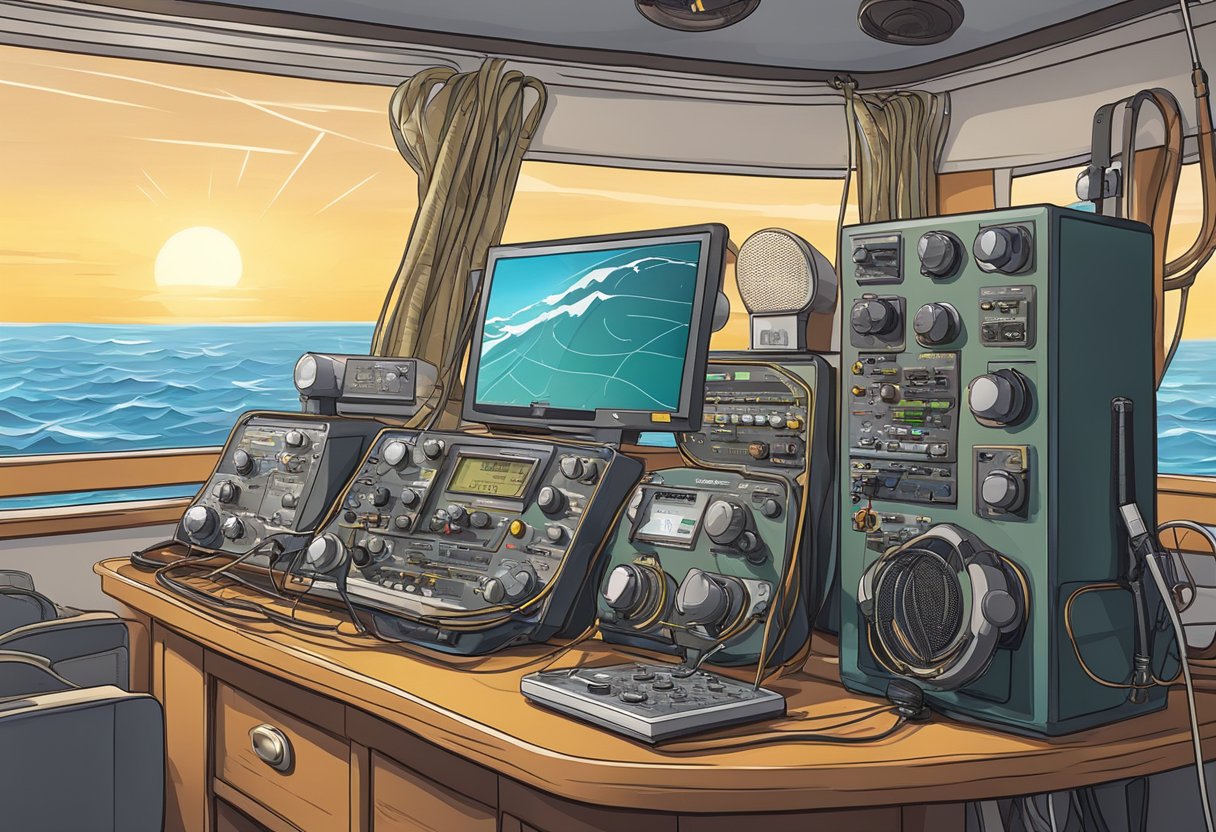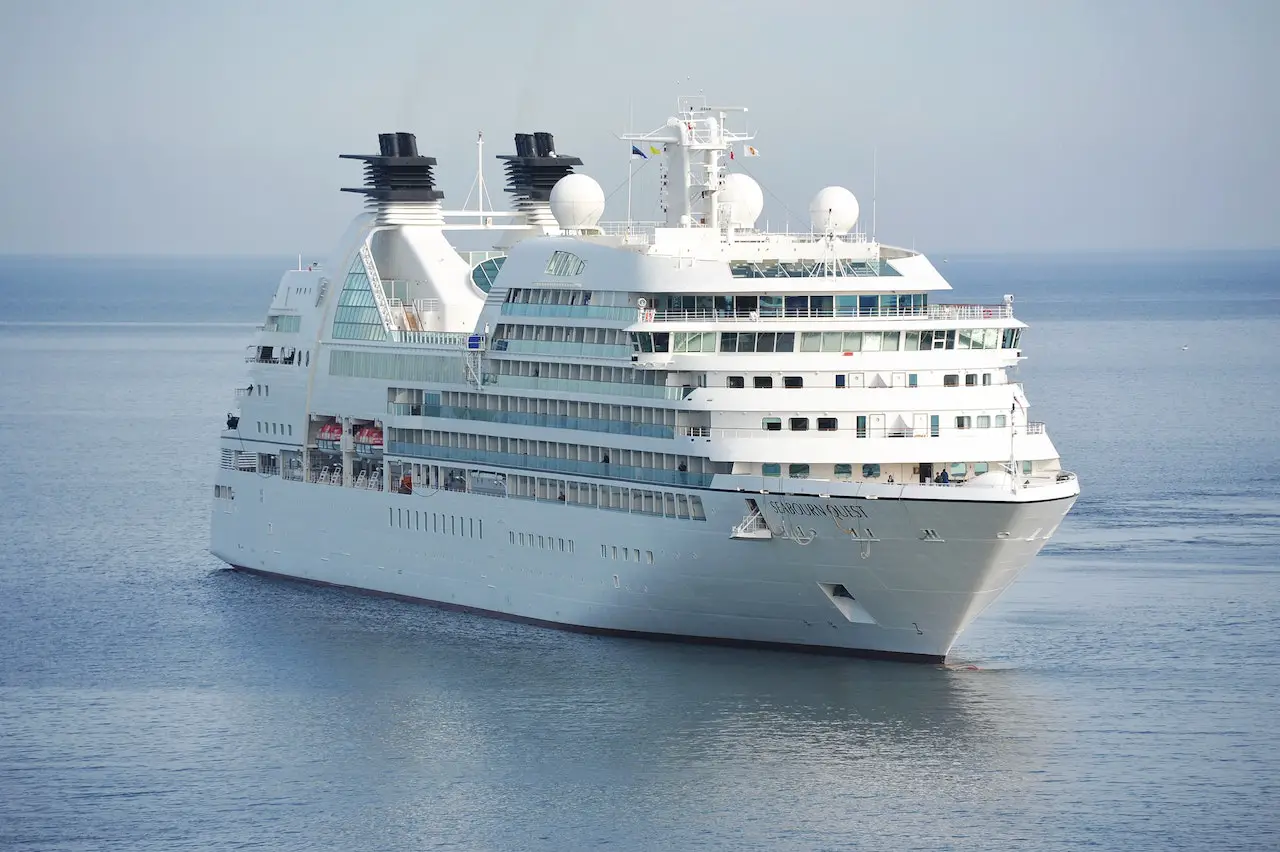Ham radio operation, also known as amateur radio, allows licensed enthusiasts the opportunity to communicate with others worldwide. The growing popularity of cruise ship vacations has led to the question of whether or not it is feasible to operate a ham radio on board. Cruise ships provide an interesting challenge for ham radio operators due to the large amount of metal comprising the ship and the international nature of the voyages.


Despite some restrictions, it is possible to bring and operate ham radios on cruise ships, but potential users need to be aware of the rules and regulations that govern this activity. Permission is often required from the cruise line and ship’s captain, and operators must abide by the laws of the countries they visit. It is essential to plan properly and understand the limitations and requirements surrounding the use of ham radio equipment while aboard a cruise ship.
Key Takeaways
- Ham radio operation on cruise ships is possible with proper planning and permissions.
- Licenses and equipment regulations need to be considered before embarking on a cruise ship with a ham radio.
- Understanding and following the rules and restrictions of the cruise line and visited countries is essential.
The Basics of Ham Radio
https://www.youtube.com/watch?v=zkfCmoABoqk&embed=true
Understanding Amateur Radio
Amateur radio, also known as ham radio, is a hobby enjoyed by millions of people around the world. It allows enthusiasts to communicate with one another using a variety of techniques and frequencies, providing opportunities to make new contacts, exchange information, and participate in contests. Ham radio operators must obtain a specific license to operate within allocated frequency bands, ensuring they adhere to regulations and maintain proper protocols.
The majority of ham radio operators make use of dual band transceivers, which enable communication on both VHF (Very High Frequency) and UHF (Ultra High Frequency) bands. VHF is typically used for local communication, while UHF works better for long-range or global communications.
Ham Radio Vs. Other Radios
Ham radio is distinct from other types of radio communication such as CB (Citizen Band) radio, FRS (Family Radio Service), and GMRS (General Mobile Radio Service) due to different frequencies, licensing requirements, and operating techniques. One significant difference is the use of continuous wave (CW) mode in amateur radio. In this mode, operators can communicate using Morse code, which is advantageous in low signal conditions where voice communication may be difficult to hear. Additionally, operational techniques such as direction finding, satellite communication, and digital modes help differentiate and expand ham radio capabilities.
Operating Techniques
There are various operating techniques in the world of amateur radio, catering to diverse communication goals and preferences. Here are a few common techniques:
- Voice communication: Using a microphone and speaker to speak directly to other operators, either in simplex mode (direct contact) or via repeaters (devices that receive and retransmit signals to increase their range).
- CW communication: As mentioned earlier, Morse code can be transmitted and received using continuous wave mode (CW), which is particularly resilient in low signal conditions.
- Digital modes: Utilizing specialized software, digital modes like PSK31, RTTY, and FT8 allow operators to send text messages or even images via radio waves. These modes are typically more efficient and reliable compared to voice and CW in challenging conditions.
In summary, ham radio is a versatile and engaging hobby, offering numerous communication methods and techniques. The use of dual band transceivers, VHF and UHF frequencies, as well as unique operating techniques like CW and digital modes, sets amateur radio apart from other radio services.
Ham Radio on Cruise Ships


Benefits of Ham Radio on Cruise Ships
Ham radio enthusiasts may find various advantages to operating their equipment while aboard cruise ships. For one, utilizing a ham radio can provide an alternative means of communication during voyages, ensuring constant connection beyond the ship’s standard communication systems. Additionally, ham radio operators may find it exciting to expand the range of their connections, given the cruise ship’s constant navigation across different regions.
Moreover, ham radio can be a unique and engaging social activity for passengers, allowing them to form connections with other ham operators around the world. This activity may provide a new dimension of entertainment during cruises, complementing the traditional onboard entertainment options.
Challenges and Issues
Despite the potential benefits of operating ham radios on cruise ships, there are some challenges that arise. One of the main concerns is the potential for ham radios to interfere with the ship’s communication, navigation systems and other onboard electronics. Interference could cause significant disruptions, and to minimize any potential risk, most cruise lines prohibit the use of amateur radios while onboard their vessels, as mentioned in this Cruise Critic thread.
There may also be limited space on a cruise ship for setting up and operating a ham radio station, making it difficult for operators to set up antennas and necessary equipment. Furthermore, acquiring permission from the cruise ship company to operate a ham radio can be a challenge, as it depends on their individual policies. While some cruise lines might be more lenient, many will not permit the use of ham radios onboard due to aforementioned reasons.
License and Approval Process


Getting a License
Operating a ham radio on a cruise ship requires having a valid license from the Federal Communications Commission (FCC) in the United States. The process for obtaining a license usually involves filling out a form and paying a one-time fee of $60 source. Licensed operators are expected to adhere to regulations and follow proper procedures to avoid interfering with ship systems or violating international laws. The type of license needed for radio operation will vary depending on whether the equipment is used for ham or marine single sideband (SSB) radio operation.
Cruise Line Approvals
Once a license is obtained, it is essential to seek approvals from the cruise line itself. Many cruise lines have rules about using amateur radios on board, and some require written authorization source. This process may include contacting the cruise line in advance and providing them with the necessary information about the radio equipment and the intended use during the voyage.
When on board the cruise ship, licensed operators should be prepared to have their equipment inspected by the ship’s master or officers source. This inspection ensures that the equipment complies with safety and regulatory requirements. It is also crucial for operators to be aware of the various international laws and regulations, as the cruise ship may sail in and out of different territories where it may be illegal to operate amateur radios or require specific licenses source.
In summary, the proper licensing and cruise line approvals are required to operate ham radios on cruise ships. Operators should follow necessary procedures, keep the equipment in good working condition, and stay updated with international laws and regulations to ensure a smooth and enjoyable experience on board.
Ham Radio Equipment for Cruise Ships
Types of Radio Equipment
Ham radio, also known as amateur radio, is a popular hobby for enthusiasts who communicate with each other using various types of radio equipment. There are various types of radio equipment that can be used on a cruise ship, such as handheld radios, mobile radios, and base station radios. Handheld radios are the most portable option, as they are small and lightweight, making them ideal for cruise ship use. Mobile radios, on the other hand, are generally larger and intended for vehicle use, while base station radios are stationary setups designed for use in a specific location, such as a home or office.
It is essential to understand that most cruise lines prohibit the use of amateur radios on board. For those who have obtained permission to use their radio equipment, it is crucial to select the appropriate type of equipment that will not interfere with the ship’s communication systems and maintain contact with other ham radio operators.
How far can Ham Radios Transmit
The transmission range of ham radios depends on various factors such as radio frequency, power output, antenna type, and atmospheric conditions. Handheld radios usually have a limited transmission range, ideal for local communication. However, with the proper setup and operating conditions, even handheld radios can transmit signals that can reach ham radio operators miles away.
On a cruise ship, with considerations for the vessel’s structure and electronic systems, there may be limitations to the effective range of a handheld radio. Furthermore, maritime laws dictate that communication involving amateur radio must be conducted according to the ARRL’s guidelines for maritime mobile operation. Thus, understanding the limitations and adhering to proper radio protocol will ensure a successful ham radio experience while on a cruise.
In conclusion, while it may be challenging to operate a ham radio on a cruise ship, obtaining permission from the cruise line and having the appropriate equipment will ensure a positive experience. As always, exercise caution and follow established guidelines when communicating via ham radio.
Regulations and Restrictions on Cruise Ships
Prohibited Items
Various cruise lines, such as Carnival Cruise Lines, have specific policies regarding prohibited items on board their ships. Amateur radios, also known as ham radios, may be prohibited or restricted depending on the cruise line’s rules. This is done to ensure the safety and security of all passengers and to avoid interference with the ship’s communication systems.
Some other prohibited items on cruise ships include firearms, ammunition, sharp objects, incapacitating substances, and flammable substances. Confiscation of such items may occur upon boarding if passengers fail to comply with these regulations.
Privacy and Ham Radio
Another reason that amateur radios may be prohibited or restricted on cruise ships is the concern for privacy. As ham radios can potentially intercept and transmit sensitive information, cruise lines may limit their use to maintain the privacy of their passengers and the confidentiality of their operations.
In some cases, ham radio operators might be allowed to bring their equipment on board if they obtain permission from the captain and use it within the guidelines set by the cruise line. However, it is always essential for passengers to check the specific regulations and restrictions of the cruise line before embarking on their journey.
User Guides and Experiences
Operating a ham radio on a cruise ship can be an exciting and enjoyable experience for amateur radio enthusiasts. Many cruisers have depended on amateur ham single sideband radio (SSB) while sailing, connecting with people from different parts of the world, exchanging greetings, and weather reports to name a few Ocean Navigator. However, cruise lines may have rules and regulations regarding the use of amateur radios on their ships.
To ensure a smooth experience, it’s recommended that you first verify your desired cruise line’s policies regarding ham radios. Contacting the cruise line in advance can spare you from potential disappointments and inconveniences. In some cases, cruise lines might allow ham radio operations after inspecting the equipment and obtaining necessary permissions Cruise Critic.
When it comes to finding suitable ham radio equipment for a cruise, choose one with a compact design, an output of 10-150 Watts or more, functioning even on low voltage, and covering all normal amateur bands Cruisers Wiki. Additionally, simplex and duplex-enabled devices with memory banks for a minimum of 50 frequencies and interference and noise elimination features will provide a better experience.
There are various online resources available to assist ham radio operators with practical knowledge and user experience. For instance, forums such as Reddit offer helpful advice and experiences shared by other radio enthusiasts. A number of smartphone apps and websites also aid operators in maximizing their ham radio experience, including logging contacts, locating nearby operators, or searching for propagation reports.
In conclusion, utilizing a ham radio while cruising is an enjoyable way to connect with like-minded individuals across the globe. By following the appropriate guidelines, communicating with the cruise line beforehand, and accessing helpful resources, you can have a seamless and rewarding ham radio experience onboard.
Buying and Building Equipment
How to Buy
When selecting ham radio equipment for a cruise ship, it’s essential to consider the size, output, and capabilities of the devices. Purchasing equipment from reputable sources guarantees that you will get high-quality and reliable products.
First, determine the size constraints of your devices. A suitable ham radio for use on a cruise ship should be compact, with dimensions no larger than 8″ wide x 2 1/2″ high x 6″ depth. Look for an output range between 10 Watts and 150 Watts. This will ensure the equipment is powerful enough for amateur radio communications without interfering with ship systems1.
Next, consider the radio’s features. It should operate on a minimum of 11 1/2 volts, cover all standard amateur bands, and be simplex and duplex enabled. Ensure that the radio has a memory bank for at least 50 frequencies and comes equipped with interference and noise elimination2.
Equipment Assembly Tips
Once you have purchased the necessary equipment, it’s time to assemble your portable amateur radio station. Here are a few tips to help with the process:
- Antenna: Choose an antenna that is compact and easy to install. Hamsticks are one option to consider3. Mount the antenna on a veranda or balcony and ground it to the ship’s hull to ensure optimal reception.
- Power supply: Ensure you have a suitable power supply for your radio. A 12-volt power source is often sufficient. It’s worth checking with the cruise ship’s regulations before connecting your equipment to the onboard electrical system.
- Cables and connectors: Use high-quality cables and connectors for all connections. This will minimize signal loss and provide a more reliable communication setup. Be mindful of wire use and keep it organized to avoid tangles and potential hazards.
- Positioning: Find a location on the ship that offers minimal interference from other electronics and provides enough space for your equipment. Avoid high-traffic areas where your setup might be disturbed.
With the right equipment and careful assembly, you can enjoy a fun and educational ham radio experience during your time at sea. Remember to adhere to all cruise ship regulations and respect the privacy of fellow passengers while operating your ham radio.
Additional Information on Ham Radio
Ham Radio Activities on Cruise Ships
Ham radio enthusiasts may find it exciting to bring their hobby on their cruise vacation. However, it is important to understand the rules and restrictions when operating ham radios on cruise ships. Some cruise liners might permit ham radio usage, while others might prohibit it due to legal or technical concerns. To ensure an enjoyable experience, it is recommended that travelers research the policies of their chosen cruise line and be prepared to comply with any regulations.
Interference with Ship Functions
One concern regarding the usage of amateur radios on cruise ships is the potential for interference with the ship’s communication and navigation systems. Cruise ships rely on a variety of technologies for daily operations. The radio frequencies used by ham radios might interfere with these systems and affect their performance, leading to potential safety risks. To maintain the quality and reliability of the ship’s services, some cruise lines might restrict the usage of amateur radios on board, striving to provide a safe and seamless experience for all passengers.
Frequently Asked Questions
Are there restrictions on using ham radios on cruise ships?
Yes, there are restrictions on using ham radios on cruise ships. Amateur radio operation can potentially interfere with the ship’s systems or be illegal in certain territories. Cruise lines may have specific rules and regulations regarding the use of ham radio equipment on board their ships. Always check with your cruise line for any policies and restrictions to ensure you are compliant with their requirements.
Do cruise lines allow ham radio equipment onboard?
Cruise lines have different policies regarding the allowance of ham radio equipment on board. Some cruise lines may allow passengers to bring ham radio equipment onboard, but only after obtaining necessary permissions and inspections. For instance, some ham radio users have successfully taken their radios on Princess and Royal Caribbean cruises. However, it is essential to contact the cruise line in advance to confirm their specific policies and procedures.
What is the range of ham radio communication on a cruise ship?
The range of ham radio communication on a cruise ship depends on the radio’s power output, antenna setup, and surrounding environment. Generally speaking, the range can vary from only a few miles to several hundred miles. However, ham radio operators should be aware of the potential interference with the ship’s communication systems and always follow the cruise ship’s guidelines.
How to safely operate a ham radio on a cruise ship?
To safely operate a ham radio on a cruise ship, follow these steps:
- Obtain permission from the cruise line to use your ham radio.
- Ensure your radio complies with the legal and technical requirements of the countries the cruise ship will be visiting.
- Use low power settings to minimize the risk of interfering with the ship’s communication systems.
- Set up your antenna and radio equipment away from any critical ship systems and navigational equipment.
- Follow relevant safety and operational procedures as advised by the cruise line and local authorities.
Is a special permit required for operating ham radios on cruise ships?
A special permit may be required to operate a ham radio on a cruise ship, depending on the jurisdiction and specific regulations of the cruise line, countries visited, and territorial waters through which the ship travels. You may need to hold an appropriate amateur radio license and abide by local regulations. Always contact your cruise line and research the relevant jurisdiction laws before bringing your ham radio equipment onboard.
What alternative communication options are available on a cruise ship?
Alternative communication options on a cruise ship can include onboard Wi-Fi, satellite phone service, and in some cases, Wi-Fi calling. Cruise lines typically offer Wi-Fi services to allow passengers to access the internet and stay connected with friends and family. However, these services can be expensive, and it is essential to review the available plans and associated costs before using them.





